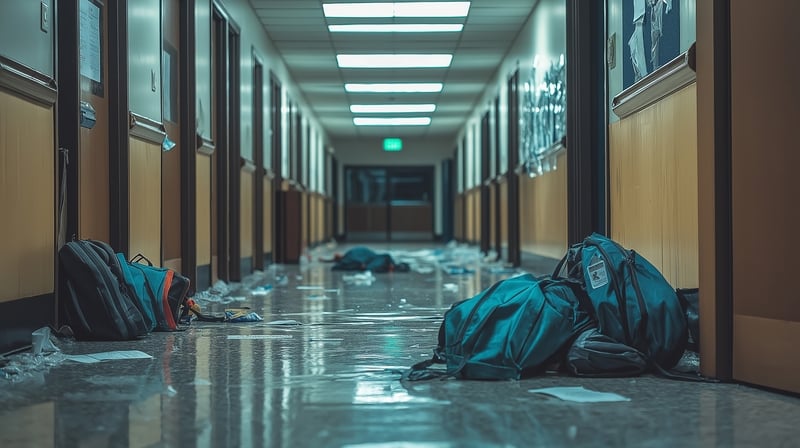TRENTON, NJ – Phil Murphy’s legacy in New Jersey might not be his COVID-19 lockdowns but his new reputation as the School Closer-In-Chief. While the governor is touting the state’s success via a rapidly increasing population consisting mostly of illegal migrants, he’s not saying much about the mass teacher layoffs and school closures surrounding him in his own state.
Murphy’s response, “You’re going to have to close a few schools.”
Unacceptable as the quality of education in America and New Jersey is in a steep decline.

New Jersey, heralded as one of the fastest-growing states in America, is facing an educational paradox under Governor Phil Murphy’s leadership.
While Murphy frequently touts population growth and economic progress, school districts across the state are shuttering their doors, leaving parents, students, and educators reeling. Far from being remembered as a champion of education, Murphy’s tenure may be defined by the controversial S2 funding formula—a policy critics argue has gutted school budgets, forced dozens of closures, and disproportionately harmed suburban communities. As the state ostensibly thrives, the question looms: why are schools closing at an alarming rate?
A Growing State, A Shrinking Education System
New Jersey’s population has indeed been on an upward trajectory in recent years, bolstered by its proximity to major metropolitan hubs like New York City and Philadelphia, as well as its reputation for strong public schools.
One of the driving factors of this growth is also Phil Murphy’s declaration that New Jersey is a sanctuary state, driving up the number of English as a Second Language (ESL) students and low-income, households in the suburbs. Yet, the state’s funding is shortchanging tens of thousands of students, particularly in those bearing the brunt of the immigration crisis, in favor of dumping a nearly endless flow of cash into corrupted and failing urban and inner city districts.
Yet, this growth has not translated into stability for its education system. Since the passage of Senate Bill 2 (S2) in 2018, signed into law by Murphy, the state has shifted its school funding model to address historical inequities, not modern day challenges for all students.
His equity plan has essentially become reverse inequity, stripping a quality education away from districts that include mostly white and Hispanic children.
The goal was far from noble and not well thought out: redirect aid to underfunded districts, often in urban areas, to ensure every child receives a quality education. However, the execution has left a trail of collateral damage, with suburban and rural districts bearing the brunt of severe budget cuts. The result? School closures, staff layoffs, and a growing sense of betrayal among communities that once prided themselves on their local schools.
Districts Forced to Close Schools Under S2
The S2 funding formula, fully phased in by the 2024-2025 school year, has led to devastating cuts for numerous districts, prompting the closure of schools that were once community anchors. Here are just three examples:
- Jefferson Township School District: In September 2024, officials announced the closure of Cozy Lake Elementary School, citing “debilitating” state aid cuts as a primary factor. The district, located in Morris County, has struggled to maintain operations as funding dwindled under S2.
- Jackson Township School District: Earlier in 2024, the Rosenauer Elementary School closed its doors, a direct consequence of budget reductions tied to S2. Jackson, an Ocean County suburb, has seen its state aid slashed, forcing tough choices like school consolidation and staff cuts. Now the district is eyeing more school closures.
- Toms River Regional School District: One of the hardest-hit districts, Toms River faces the potential closure of one of its three intermediate schools. The district has lost millions in state aid since S2’s implementation, leading to projections of increased class sizes and the elimination of hundreds of teaching positions.
These closures are not isolated incidents but part of a broader pattern affecting dozens of districts statewide. From rural Jefferson to sprawling Toms River, the loss of neighborhood schools has disrupted education and uprooted community stability.
The Impact of S2 Funding on Suburban Communities
Suburban communities, often characterized by stable tax bases and high-performing schools, have been blindsided by S2’s repercussions. The formula, designed to phase out “adjustment aid” that once supported districts with stagnant or declining enrollment, has redirected funds to growing, often urban districts like Newark and Plainfield. While this has bolstered resources in those areas—Plainfield, for instance, gained $30 million in the 2025 budget—suburban districts have seen their budgets erode.
The impact is profound. In Toms River, a district serving over 15,000 students, the loss of $42 million in cumulative aid has sparked protests and lawsuits against the state. Schools have cut 77 positions in a single year, with more reductions looming. In Jackson, the closure of Rosenauer Elementary has forced students into overcrowded classrooms elsewhere, straining resources and stretching transportation budgets thin. Parents in these communities lament the loss of local schools, which often served as hubs for extracurricular activities and social cohesion.
Beyond logistics, the funding cuts have exacerbated property tax pressures. New Jersey already has some of the highest property taxes in the nation, and districts losing state aid have few options but to raise levies—a move capped at 2% unless voters approve higher increases. For suburban families, this double blow—fewer schools and higher taxes—feels like a betrayal of the promise that drew them to these areas in the first place.
A Political Punishment? Perceptions of Bias
A contentious narrative has emerged among critics: that Murphy is penalizing children in districts that didn’t support him politically. Posts on X and local commentary often highlight a perceived correlation between aid cuts and voting patterns, with suburban and rural areas—many of which lean Republican—bearing the heaviest losses.
Toms River and Jackson, both in Ocean County, a GOP stronghold, exemplify this trend. Meanwhile, urban districts like Jersey City, which received $33.7 million in supplemental aid in 2023, and Plainfield, a Democratic bastion, have seen funding boosts.
While no concrete evidence proves Murphy intentionally targeted non-supportive districts, the optics fuel distrust.
Everyone knows what’s really happening.
During a 2024 interview, Murphy attributed Toms River’s woes to its lack of “large industries” or “dense population,” a comment that struck many as dismissive of suburban realities.
Critics argue that the S2 formula, championed by Murphy and Democratic legislative allies like Senate President Stephen Sweeney, reflects a broader urban-centric agenda that overlooks the needs of middle-class families in less dense areas. Whether intentional or not, the perception of political retribution has deepened the divide between the governor and affected communities.
A Legacy in Question
Phil Murphy may have entered office in 2018 with a pledge to fully fund New Jersey’s schools, a promise he technically fulfilled by 2025 under the School Funding Reform Act. Yet, this achievement rings hollow for the families watching their schools close. The S2 formula, intended to create equity, has instead sown chaos, forcing districts to shutter buildings, lay off teachers, and consolidate resources at a time when the state’s population is growing. For many, Murphy will be remembered not as an education advocate but as the governor who oversaw the erosion of a once-vaunted system.
As New Jersey continues to expand, the closure of dozens of schools stands as a stark contradiction to its growth narrative. Suburban communities, caught in the crosshairs of S2, are left to pick up the pieces—financially, educationally, and emotionally. Whether driven by policy missteps or political calculus, the fallout ensures that Murphy’s legacy will be debated long after he leaves office, with the shuttered schoolhouses serving as enduring symbols of a promise unfulfilled.

